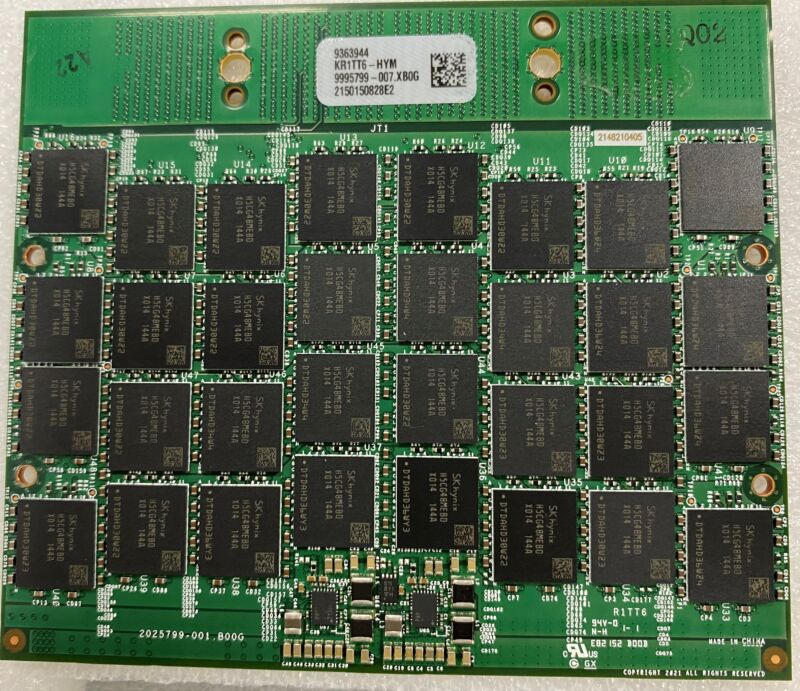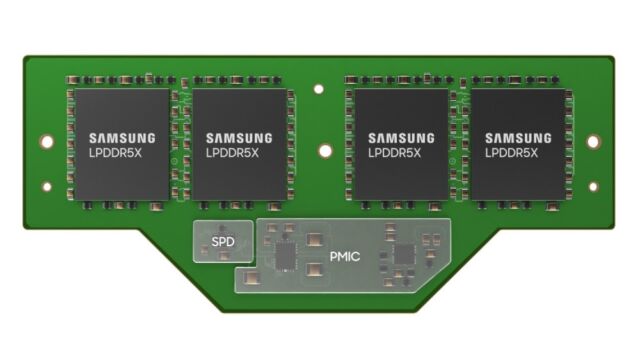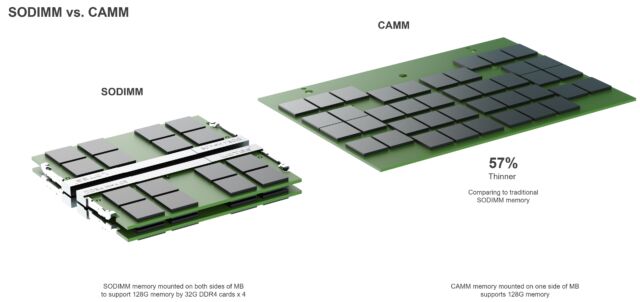compression attached —
Dell introduced CAMM in 2022 with modules that were 57% thinner than SO-DIMM.

Enlarge / The front of a 128GB Dell CAMM.
Dell
Move over, SO-DIMM. A new type of memory module has been made official, and backers like Dell are hoping that it eventually replaces SO-DIMM (small outline dual in-line memory module) entirely.
This month, JEDEC, a semiconductor engineering trade organization, announced that it had published the JESD318: Compression Attached Memory Module (CAMM2) standard, as spotted by Tom’s Hardware.
CAMM2 was originally introduced as CAMM via Dell, which has been pushing for standardization since it announced the technology at CES 2022. Dell released the only laptops with CAMM in 2022, the Dell Precision 7670 and 7770 workstations.
The standard includes DDR5 and LPDDR5/5X designs. The former targets “performance notebooks and mainstream desktops,” and the latter is for “a broader range of notebooks and certain server market segment,” JEDEC’s announcement said.
They each have the same connector but differing pinouts, so a DDR5 CAMM2 can’t be wrongfully mounted onto an LPDDR5/5X connector. CAMM2 means that it will be possible to have non-soldered LPDD5X memory. Currently, you can only get LPDDR5X as soldered chips.
Another reason supporters are pushing CAMM2 is in consideration of speed, as SO-DIMM tops out at 6,400 MHz, with max supported speeds even lower in four-DIMM designs. Many mainstream designs aren’t yet at this threshold. But Dell originally proposed CAMM as a way to get ahead of this limitation (largely through closer contact between the module and motherboard). The published CAMM2 standard says LPDDR5 DRAM CAMM2 “is expected to start at 6,400 MTs and increment upward in cadence with the DRAM speed capabilities.”
Samsung in September announced plans to offer LPDDR CAMM at 7.5Gbps, noting that it expects commercialization in 2024. Micron also plans to offer CAMM at up to 9,600Mbps and 192GB-plus per module in late 2026, as per a company road map shared by AnandTech last month. Both announcements were made before the CAMM2 standard was published, and we wouldn’t be surprised to see timelines extended.

Enlarge / Samsung shared this rendering of a CAMM ahead of the publishing of the CAMM2 standard in September.
CAMM2 supports capacities of 8GB to 128GB on a single module. This opens the potential for thinner computer designs that don’t sacrifice memory or require RAM modules on both sides of the motherboard. Dell’s Precision laptops with Dell’s original CAMM design is 57 percent thinner than SO-DIMM, Dell said. The laptops released with up to 128GB of DDR5-3600 across one module and thinness as low as 0.98 inches, with a 16-inch display.

Enlarge / A Dell rendering depicting the size differences between SO-DIMM and CAMM.
Dell
Nominal module dimensions listed in the standard point to “various” form factors for the modules, with the X-axis measuring 78 mm (3.07 inches) and the Y-axis 29.6–68 mm (1.17–2.68 inches).
Computers can also achieve dual-channel memory for more bandwidth with one CAMM compared to SO-DIMM’s single-channel design. Extra space could lead to better room for things like device heat management.
JEDEC’s announcement said:
By splitting the dual-channel CAMM2 connector lengthwise into two single-channel CAMM2 connectors, each connector half can elevate the CAMM2 to a different level. The first connector half supports one DDR5 memory channel at 2.85mm height while the second half supports a different DDR5 memory channel at 7.5mm height. Or, the entire CAMM2 connector can be used with a dual-channel CAMM2. This scalability from single-channel and dual-channel configurations to future multi-channel setups promises a significant boost in memory capacity.
Unlike their taller SO-DIMM counterparts, CAMM2 modules press against an interposer, which has pins on both sides to communicate with the motherboard. However, it’s also worth noting that compared to SO-DIMM modules, CAMM2 modules are screwed in. Upgrades may also be considered more complex since going from 8GB to 16GB, for example, would require buying a whole new CAMM and getting rid of the prior rather than only buying a second 8GB module.
JEDEC’s standardization should eventually make it cheaper for these parts to be created and sourced for different computers. It could also help adoption grow, but it will take years before we can expect this CAMM2 to overtake 26-year-old SO-DIMM, as Dell hopes. But with a few big names behind the standard and interest in thinner, more powerful computers, we should see a greater push for these modules in computers in the coming years.
You can download the CAMM2 standard from JEDEC’s website.